Creating Diverse Patterns on Thin Polystyrene Film through Water-in-Oil Emulsion Coating and Utilizing the Derived Hydrophilic Holes as a Microreactor
Abstract
:1. Introduction
2. Materials and Methods
2.1. Chemicals and Materials
2.2. Preparation of Patterned PS Films through Emulsion Coating
2.3. Crystallization of Acrylamide in the Hydrophilic Bowl-Shaped Holes over the PS Coating Film
2.4. Growth of Nickel Micro-Needles in the Hydrophilic Bowl-Shaped Holes over the PS Coating Film Using an Electroless Nickel (EN) Plating Technique
2.4.1. Preparation of a Sensitization and Activation Solution
2.4.2. Formulation of Acidic Hypophosphite EN Plating Solution
2.4.3. The EN Plating Protocol
- i.
- A PS_Span80_0.67 film (2.2 × 2.2 cm2) was sensitized and activated by dipping it in the activation solution for about 3 min. The film was then rinsed with DI water and dipped in the 1 M HCl solution for about 30 s to remove Sn4+ generated from the sensitization and activation treatment. Subsequently, the film was rinsed with DI water and left to dry in a ventilation hood to obtain an activated PS film for EN.
- ii.
- In the subsequent plating step, 50 mL of the EN plating solution was first transferred to an 80 mL crystallizing dish placed in a water bath and warmed to 89 ± 1° under magnetic stirring. The activated PS film was then immersed in the EN solution for a duration ranging from 30 to 120 s to conduct the plating. After plating, the film was rinsed with DI water, air-dried, and further dried in a vacuum oven for about 1 h. Finally, the Ni-P-deposited film, named the PS-SP80_0.67-Ni30 film, was achieved, where 30 stands for a duration of 30 s of this plating step.
2.5. The Deposition of Copper Nanoparticles in the PS Film
2.6. Structural Characterizations
2.6.1. Molecular Weight of PS and Its Viscosity in Chloroform
2.6.2. Uncovering the Surface Pattern Using Atomic Force Microscopy (AFM)
2.6.3. Examination of the Impact of a Surfactant on the Phase Structure of a Patterned PS Film Using Differential Scanning Calorimetry (DSC)
2.6.4. Recording the Surface Morphology Images and Compositions of the Patterned/Deposited PS Films by Scanning Electron Microscopy (SEM)
2.6.5. Observing Cu Nanoparticles Embedded in PS Film with Transmission Electron Microscopy (TEM)
2.6.6. Examination of the Adsorption of the Embedded Nano-Copper Particles Using Ultraviolet–Visible (UV–VIS) Spectroscopy
2.6.7. Determination of the Structures of the Crystallites Growing on or within the PS Films by X-ray Diffraction (XRD) Analysis
3. Results and Discussion
3.1. Influences of the Nature of the Surfactant on the Pattern Development over the Coating and Drying Course
3.1.1. The Impact of Cationic Surfactant (CTAB)
3.1.2. The Impact of Anionic Surfactant (AOT)
3.1.3. The Impact of Non-Ionic Surfactants
3.1.4. A Qualitative Assessment of Polystyrene–Surfactant Interactions and the Surface Properties of the Patterned Films
3.2. Utilization of Honeycomb Holes on the PS_Span-80_0.67 Film to Grow Pure Acrylamide Crystallite
3.3. Utilization of Honeycomb Holes on the PS_Span-80_0.67 Film to Grow Ni-P Alloy Micro-Needles
3.4. In Situ Growth of Copper Nanoparticles (NP) Inside the Dispersed Droplets during the Drying of the Cast w/o Emulsion
4. Conclusions
- i.
- Both CTAB and Span-80 trigger a uniform and dense distribution of round holes, but the latter incurs a greater RMS. AOT cultivates an M-shaped pattern with the lowest RMS level. Among the three surfactants, the longer the aliphatic tail, the stronger the pattering capability.
- ii.
- Compared to Span-80, Span-20 exhibits a significantly weaker surface pattern-inducing capability despite having a similar molecular structure, as evidenced by the hole density and RMS. This reflects the sensitivity of the hydrophobic tail length and bond type. Moreover, Span-20 produces a surface pattern similar to that produced by the very hydrophilic Tergitol-12, suggesting that the molecular environment of the tails in PS plays a crucial role in determining the film surface morphology.
- iii.
- The addition of a surfactant to PS lowers its glass transition temperature and its endothermic properties due to the increased free volume within the PS film bulk. Furthermore, CTAB molecules undergo ionic association and Span-80s form hydrogen-bond clusters, respectively, at the film–air interface, driven by their linear tail structures, thereby contributing to the strength of endothermic transitions.
- iv.
- The Span-80-induced surface pattern, represented by bowl-shaped holes, was utilized as a microreactor to investigate the impact of its hydrophilic curvature at a micron-scale on the following two deposition reactions.
- *
- Recrystallization of acrylamide achieved a pure monoclinic lattice, attributed to hydrogen-bonding-initiated seeding.
- *
- Electroless Ni plating deposited Ni-P alloy dendrites with a high P % content, which was attributed to the spatial confinement of the surface hole chamber.
- v.
- Reduction of the [Cu(4VPy)2]2+ complex ion inside the dispersed aqueous droplets of the Span-80-stabilized emulsion yields a PS film with uniformly embedded Cu nanoparticles (<16 nm), whose surface plasmon resonance appear at a lower frequency than the known ones, manifesting the micro-templating effect.
Supplementary Materials
Author Contributions
Funding
Institutional Review Board Statement
Informed Consent Statement
Data Availability Statement
Acknowledgments
Conflicts of Interest
References
- Steward, P.A.; Hearn, J.; Wilkinson, M.C. An overview of polymer latex film formation and properties. Adv. Colloid Interface Sci. 2000, 86, 195–267. [Google Scholar] [CrossRef]
- Brito, E.L.; Ballard, N. Film formation of hard-core/soft-shell latex particles. J. Polym. Sci. 2023, 61, 410–421. [Google Scholar] [CrossRef]
- Swarup, S.; Schoff, C.K. A survey of surfactants in coatings technology. Prog. Org. Coat. 1993, 23, 1–22. [Google Scholar] [CrossRef]
- Enekvist, M.; Liang, X.; Zhang, X.; Dam-Johansen, K.; Kontogeorgis, G.M. Computer-aided design and solvent selection for organic paint and coating formulations. Prog. Org. Coat. 2022, 162, 106568. [Google Scholar] [CrossRef]
- Walker, J.; Schofield, A.B.; Koutsos, V. Nanostructures and thin films of poly(ethylene glycol)-based surfactants and polystyrene nanocolloid particles on mica: An atomic force microscopy study. Coatings 2023, 13, 1187. [Google Scholar] [CrossRef]
- Karthaus, O.; Ijiro, K.; Shimomura, M. Ordered self-assembly of nanosize polystyrene aggregates on mica. Chem. Lett. 1996, 25, 821–822. [Google Scholar] [CrossRef]
- Wang, M.; Zhang, L. Hole pattern in polymer films and its template effect on the growth of gold particles. Thin Solid Film 2000, 359, 82–87. [Google Scholar] [CrossRef]
- Sato, Y.; Singai, T.; Hatakeyama, K.; Wakaki, S.; Takahashi, T.; Nasu, A. Observation of OW·WO emsion coating film formed by doctor blade applicator. J. Coat. Technol. Res. 2022, 19, 1117–1126. [Google Scholar] [CrossRef]
- Ookura, R.; Nishida, J.; Nishikawa, T.; Shimomura, M. Stabilization of micropatterned polymer films as artificial extracellular matrices for tissue engineering. Mol. Cryst. Liq. Cryst. 1999, 337, 461–464. [Google Scholar] [CrossRef]
- Choi, S.; Min, S.-B.; Jeon, D.; Kim, C.B. Marangoni-driven patterning in polymer thin film supported on shrinking substrate for resolution enhancement. Macromol. Chem. Phys. 2023, 224, 2300035. [Google Scholar] [CrossRef]
- Bormashenko, E.; Pogreb, R.; Stanevsky, O.; Bormashenko, Y.; Stein, T.; Gaisin, V.-Z.; Cohen, R.; Gendelman, O.V. Mesoscopic patterning in thin polymer films formed under the fast dip-coating process. Macromol. Mater. Eng. 2005, 290, 114–121. [Google Scholar] [CrossRef]
- Müller-Buschbaum, P. Dewetting and pattern formation in thin polymer films as investigated in real and reciprocal space. J. Phys. Condens. Matter. 2003, 15, R1549–R1582. [Google Scholar] [CrossRef]
- Liu, C.X.; Lang, W.Z.; Shi, B.B.; Guo, Y.J. Fabrication of ordered honeycomb porous polyvinyl chloride (PVC) films by breath figures method. Mater. Lett. 2013, 107, 53–54. [Google Scholar] [CrossRef]
- Xue, L.; Han, Y. Pattern formation by dewetting of polymer thin film. Prog. Polym. Sci. 2011, 36, 269–293. [Google Scholar] [CrossRef]
- Telford, A.M.; Thickett, S.C.; Neto, C. Functional patterned coatings by thin polymer film dewetting. J. Colloid Interface Sci. 2017, 507, 453–469. [Google Scholar] [CrossRef]
- Escalé, P.; Rubatat, L.; Billon, L.; Save, M. Recent advances in honeycomb-structured porous polymer films prepared via breath figures. Eur. Polym. J. 2012, 48, 1001–1025. [Google Scholar] [CrossRef]
- Peng, J.; Han, Y.; Fu, J.; Yang, Y.; Li, B. Formation of regular hole pattern in polymer films. Macromol. Chem. Phys. 2003, 204, 125–130. [Google Scholar] [CrossRef]
- Lv, G.; Tian, H.; Shao, J.; Yu, D. Pattern formation in thin polymeric films via electrohydrodynamic patterning. RCS Adv. 2022, 12, 9681–9697. [Google Scholar] [CrossRef]
- Vyas, J.; Pandey, R.K. Determination of HLB value by saponification method: A brief review. Nat. J. Pharm. Sci. 2021, 1, 23–24. [Google Scholar]
- Nollet, M.; Boulghobra, H.; Calligaro, E.; Rodier, J.D. An efficient method to determine the Hydrophile-Lipophile Balance of surfactants using the phase inversion temperature deviation of CiEj/n-octane/water emulsions. Int. J. Cosmetic Sci. 2019, 41, 99–108. [Google Scholar] [CrossRef]
- Poornima Kalyanram, P.; Patricia Valenzuela, P.; Anju R Gupta, A.R. 2017. Aerosol-Ot Stabilized Micro and Nano-Scale Emulsions for Pharmaceutical Formulations. Org. Med. Chem. Int. J. 2017, 4, 88–90. [Google Scholar]
- Hensel, J.K.; Carpenter, A.P.; Ciszewski, R.K.; Schabes, B.K.; Kittredge, C.T.; Moore, F.G.; Richmond, G.L. Molecular characterization of water and surfactant AOT at nanoemulsion surfaces. Proc. Natl. Acad. Sci. USA 2017, 114, 13351–13356. [Google Scholar] [CrossRef]
- Barut, K.D.; Coşkun Ari, F.F.; Öner, F. Development and characterization of a cationic emulsion formulation as a potential pDNA carrier system. Turk. J. Chem. 2005, 29, 4. [Google Scholar]
- Dos Santos, A.Z.M.; Morais, W.A.; de Sousa, E.A.; Dantas Neto, A.A.; Dantas, T.N.C.; Pereira, M.R.; Fonseca, J.L.C. Rheology of inverse emulsions with chitosan, ctab, and cyclohexane. Soft Mater. 2009, 7, 185–197. [Google Scholar] [CrossRef]
- Liu, Z.; Yin, Y.; Eginligil, M.; Wang, L.; Liu, J.; Huang, W. Two-dimensional conjugated microporous polymer films: Fabrication strategies and potential applications. Polym. Chem. 2021, 12, 807–821. [Google Scholar] [CrossRef]
- Sarabia-Vallejos, M.A.; Cerda-Iglesias, F.E.; Pérez-Monje, D.A.; Acuña-Ruiz, N.F.; Terraza-Inostroza, C.A.; Rodríguez-Hernández, J.; González-Henríquez, C.M. Smart polymer surfaces with complex wrinkled patterns: Reversible, non-planar, gradient, and hierarchical structures. Polymers 2023, 15, 612. [Google Scholar] [CrossRef]
- Zhang, X.; Yang, L.; Wang, F.; Cheng, Z.; Liang, H. Wrinkled surface microstructure for enhancing the infrared spectral performance of radiative cooling. Opt. Express 2021, 29, 11416–11432. [Google Scholar] [CrossRef]
- Crut, A.; Maioli, P.; Fatti, N.D.; Vallée, F. Acoustic vibrations of metal nano-objects: Time-domain investigations. Phy. Rep. 2015, 549, 1–43. [Google Scholar] [CrossRef]
- Paulo, B.B.; Andreola, K.; Taranto, O.; Ferreira, A.D.; Prata, A.S. Coating approach for a phase change material (PCM). Powder Technol. 2019, 341, 147–156. [Google Scholar] [CrossRef]
- Yim, Y.-J.; Rhee, K.Y.; Park, S.-J. Electromagnetic interference shielding effectiveness of nickel-plated MWCNTs/high-density polyethylene composites. Compos. Part B Eng. 2016, 98, 120–125. [Google Scholar] [CrossRef]
- Fox, C.B.; Lin, S.; Sivananthan, S.J.; Dutill, T.S.; Forseth, K.T.; Reed, S.G.; Vedvick, T.S. Effects of emulsifier concentration, composition, and order of addition in squalene-phosphatidylcholine oil-in-water emulsions. Pharm. Dev. Technol. 2011, 16, 511–519. [Google Scholar] [CrossRef]
- Bournigault-Nuquet, A.; Couderc, S.; Bibette, J.; Baudry, J. Patterning of a drying emulsion film. Langmuir 2021, 37, 8924–8928. [Google Scholar] [CrossRef]
- Ramisetty, K.A.; Pandit, A.B.; Gogate, P.R. Ultrasound assisted preparation of emulsion of coconut oil in water: Understanding the effect of operating parameters and comparison of reactor designs. Chem. Eng. Proc. 2015, 88, 70–77. [Google Scholar] [CrossRef]
- L’Estimé, M.; Schindler, M.; Shahidzadeh, N.; Bonn, D. Droplet size distribution in emulsions. Langmuir 2024, 40, 275–281. [Google Scholar] [CrossRef]
- Shyichuk, A.; Ziółkowska, D.; Szulc, J. Coagulation of hydrophobic ionic associates of cetyltrimethylammonium bromide and carrageenan. Molecules 2023, 28, 7584. [Google Scholar] [CrossRef]
- Zhang, T.; Xu, G.; Li, Z.-F.; Regev, O.; Maddumaarachchi, M.; Blum, F.D. PS/CTAB/silica composites from room temperature polymerization of high internal phase emulsion gels. J. Colloid Interface Sci. 2015, 451, 161–169. [Google Scholar] [CrossRef]
- Tan, Z.; Zhang, Y.; Dai, C.; Li, L.; Li, Y.; Xie, X. Investigation of AOT/isooctane/water reverse microemulsion system with the presence of different mass ratios of SDS: Conductivity and water solubilization. Colloids Surf. A Physicochem. Eng. Asp. 2022, 648, 129271. [Google Scholar] [CrossRef]
- Zhao, Y.; Urban, M.W. Polystyrene/Poly(n-butyl acrylate) Latex Blend Coalescence, Particle Size Effect, and Surfactant Stratification: A Spectroscopic Study. Macromolecules 2000, 33, 7573–7581. [Google Scholar] [CrossRef]
- Schott, H. Hydrophilic-lipophilic balance, solubility parameter, and oil-water partition coefficient as universal parameters of nonionic surfactants. J. Pharm. Sci. 1995, 84, 1215–1222. [Google Scholar] [CrossRef]
- Stefanis, E.; Panayiotou, C. Prediction of Hansen solubility parameters with a new group-contribution method. Int. J. Thermophys. 2008, 29, 568–585. [Google Scholar] [CrossRef]
- Kato, Y.; Tsutsumi, S.; Fujiwara, N.; Yamamoto, H. Measurements of the Hansen solubility parameters of mites and cockroaches to improve pest control applications. Heliyon 2019, 5, e01853. [Google Scholar] [CrossRef] [PubMed]
- Schott, H. Solubility Parameter and hydrophilic-lipophilic balance of nonionic surfactants. J. Pharm. Sci. 1984, 73, 790–792. [Google Scholar] [CrossRef] [PubMed]
- Mieczkowski, R. The determination of the solubility parameter components of polystyrene by partial specific volume measurements. Eur. Polym. J. 1988, 24, 1185–1189. [Google Scholar] [CrossRef]
- Law, K.-Y. Contact angle hysteresis on smooth/flat and rough surfaces. interpretation, mechanism, and origin. Acc. Mater. Res. 2022, 3, 1–7. [Google Scholar] [CrossRef]
- Pierri, E.; Dalas, E. The precipitation of ferric phosphate on porous polymer. Colloids Surf. A Physicochem. Eng. Asp. 1998, 139, 335–340. [Google Scholar] [CrossRef]
- Ott, A.W.; Chang, R.P.H. Atomic layer-controlled growth of transparent conducting ZnO on plastic substrates. Mater. Chem. Phys. 1999, 58, 132–138. [Google Scholar] [CrossRef]
- Yin, X.; Hong, L.; Chen, B.-H.; Ko, T.-M. Modelling the stability of electroless plating bath—Diffusion of nickel colloidal particles from the plating frontier. J. Colloid Interface Sci. 2003, 262, 89–96. [Google Scholar] [CrossRef]
- Gong, D.; Cai, J.; Li, X.; Zhang, D. Magnetic helical microswimmers made by spirulina through electroless nickel plating. In Proceedings of the 2018 IEEE 13th Annual International Conference on Nano/Micro Engineered and Molecular Systems (NEMS), Singapore, 22–26 April 2018; pp. 515–518. [Google Scholar] [CrossRef]
- Sun, Z.; Huang, J.; Wang, L.; Zhang, X.; Li, M.; Tang, B. Method for electroless nickel plating on poly(ethylene terephthalate) substrate modified with primer and self-assembled monolayer. J. Mater. Sci. Mater. Electron. 2015, 26, 10132–10137. [Google Scholar] [CrossRef]
- Zhang, Y.; Tan, K.L.; Yang, G.H.; Kang, E.T.; Neoh, K.G. Electroless plating of copper and nickel via a Sn-free process on polyimide films modified by surface graft polymerization with 1-vinylimidazole. J. Electrochem. Soc. 2001, 148, C574. [Google Scholar] [CrossRef]
- Ramyadevi, J.; Jeyasubramanian, K.; Marikani, A.; Rajakumar, G.; Rahuman, A.A.; Santhoshkumar, T.; Kirthi, A.V.; Jayaseelan, C.; Marimuthu, S. Copper nanoparticles synthesized by polyol process used to control hematophagous parasites. Parasitol. Res. 2011, 109, 1403–1415. [Google Scholar] [CrossRef]
- Amaliyah, S.; Pangesti, D.P.; Masruri, M.; Sabarudin, A.; Sumitro, S.B. Green synthesis and characterization of copper nanoparticles using Piper retrofractum Vahl extract as bioreductor and capping agent. Heliyon 2020, 6, e04636. [Google Scholar] [CrossRef] [PubMed]
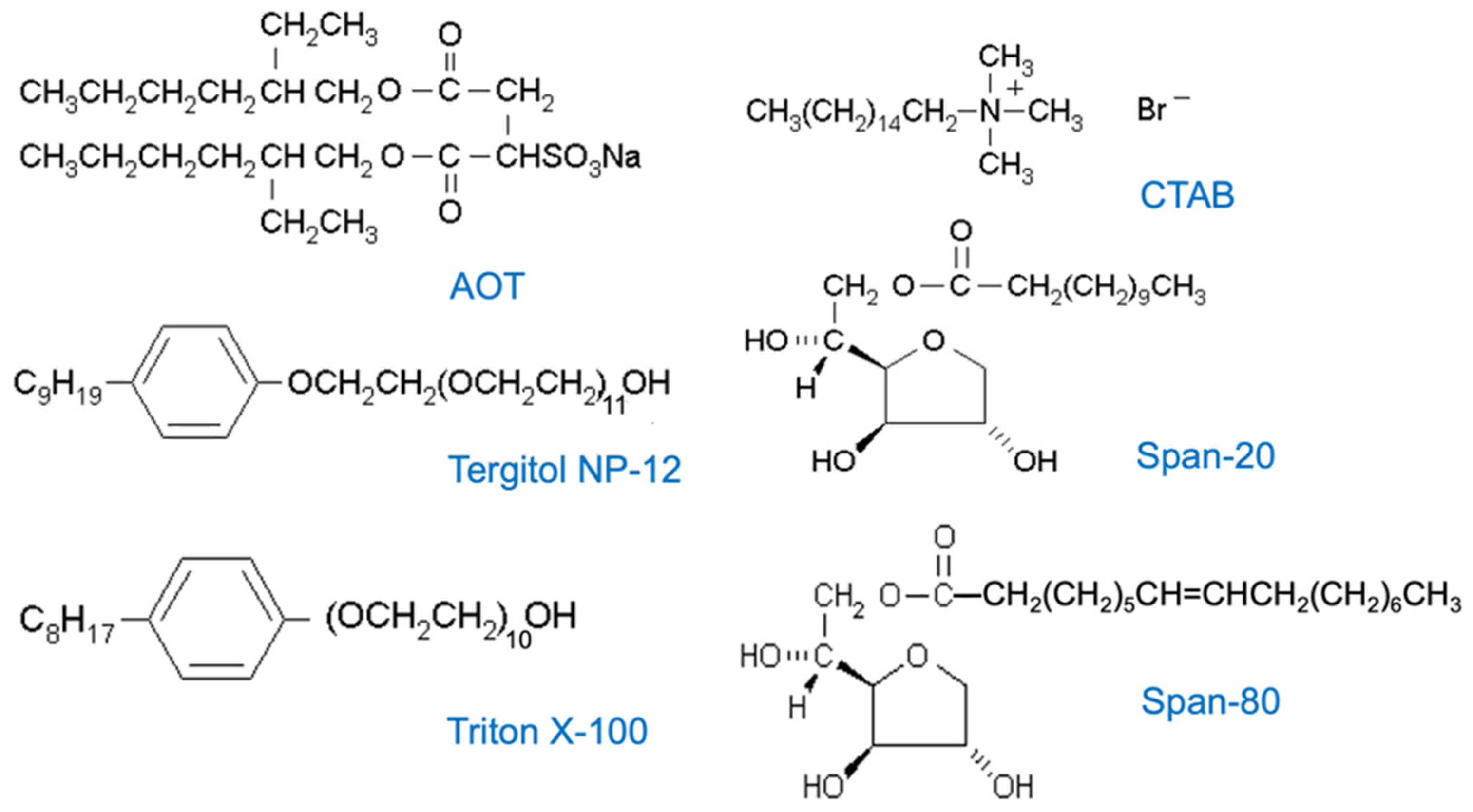

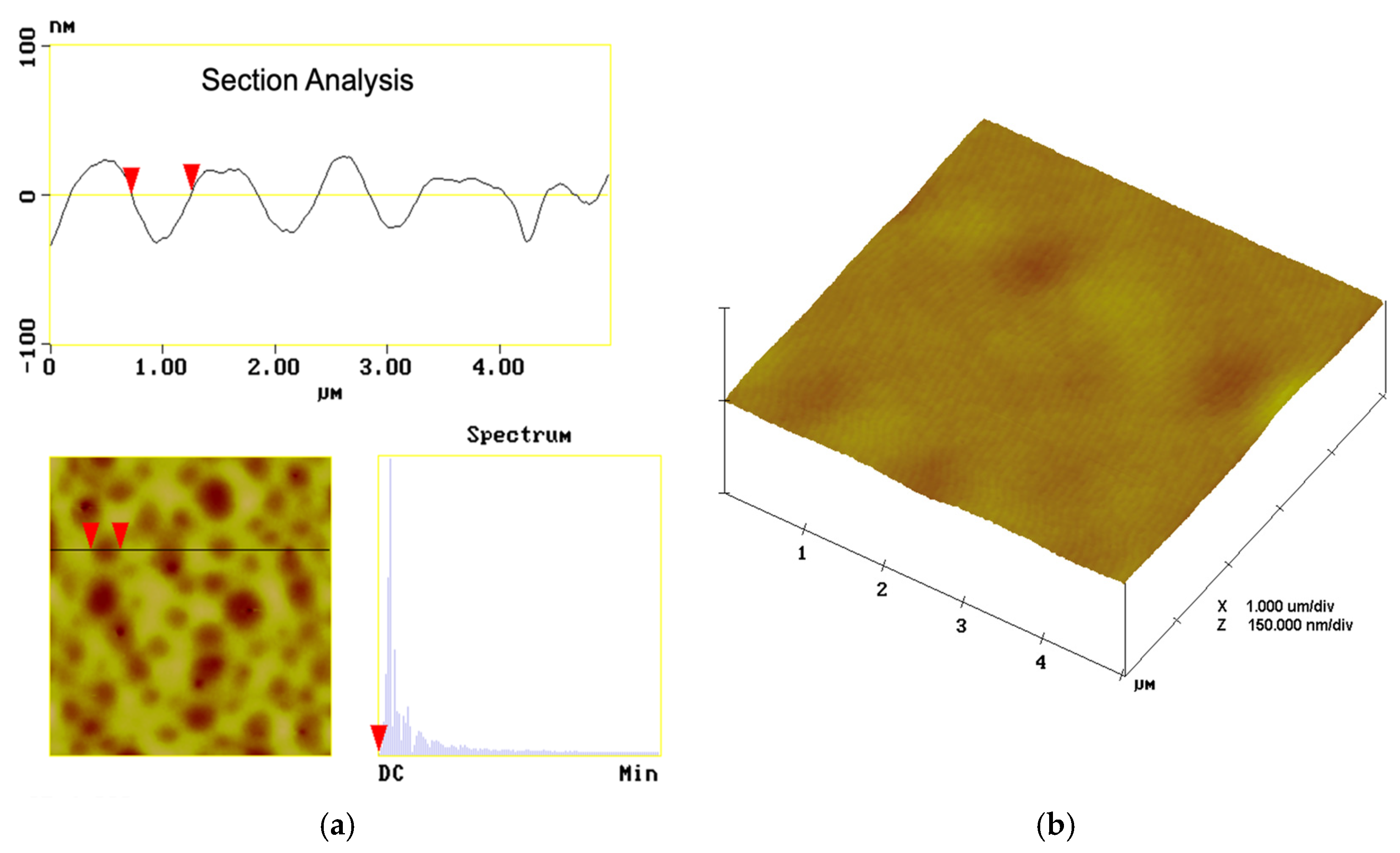

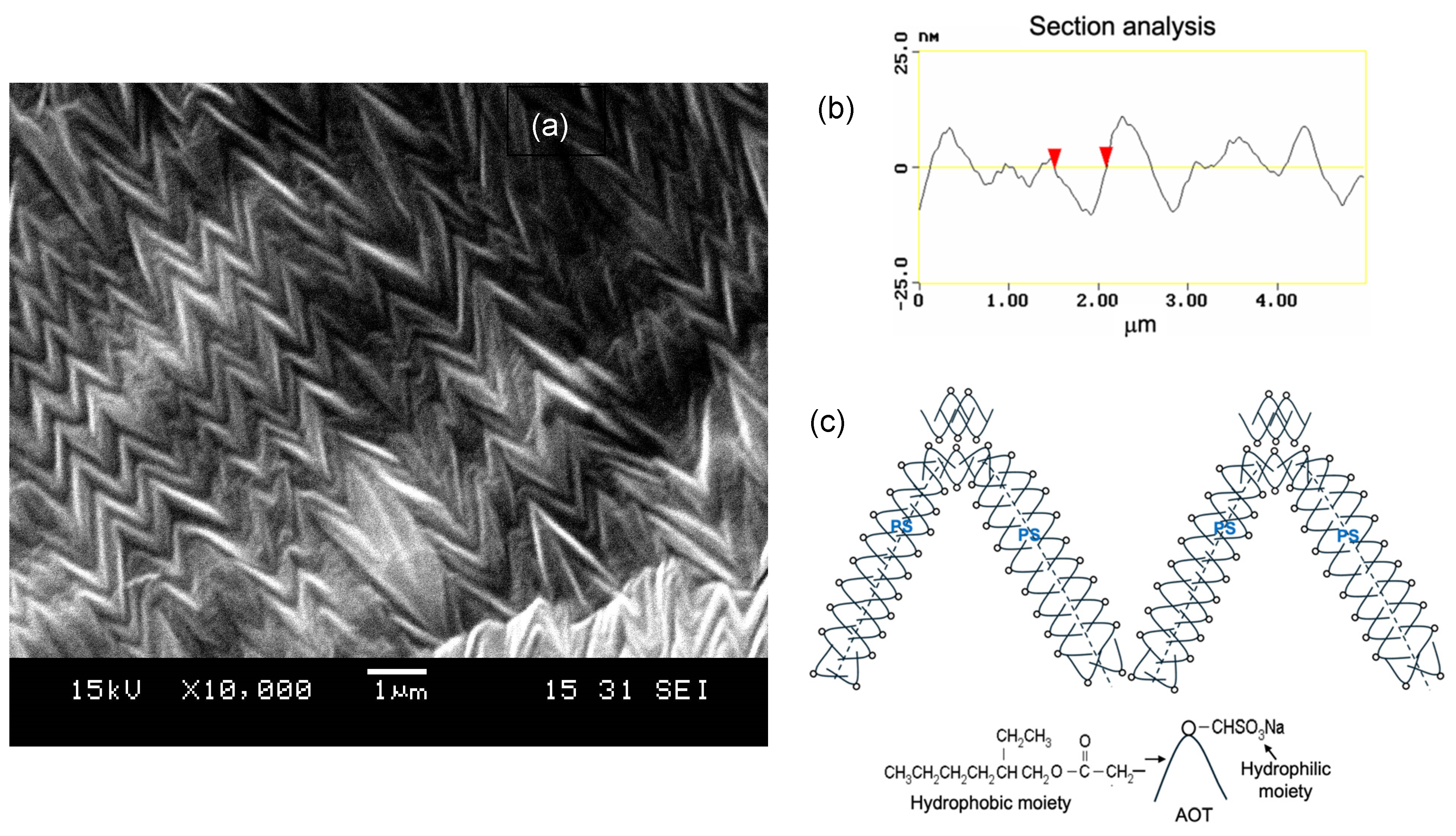
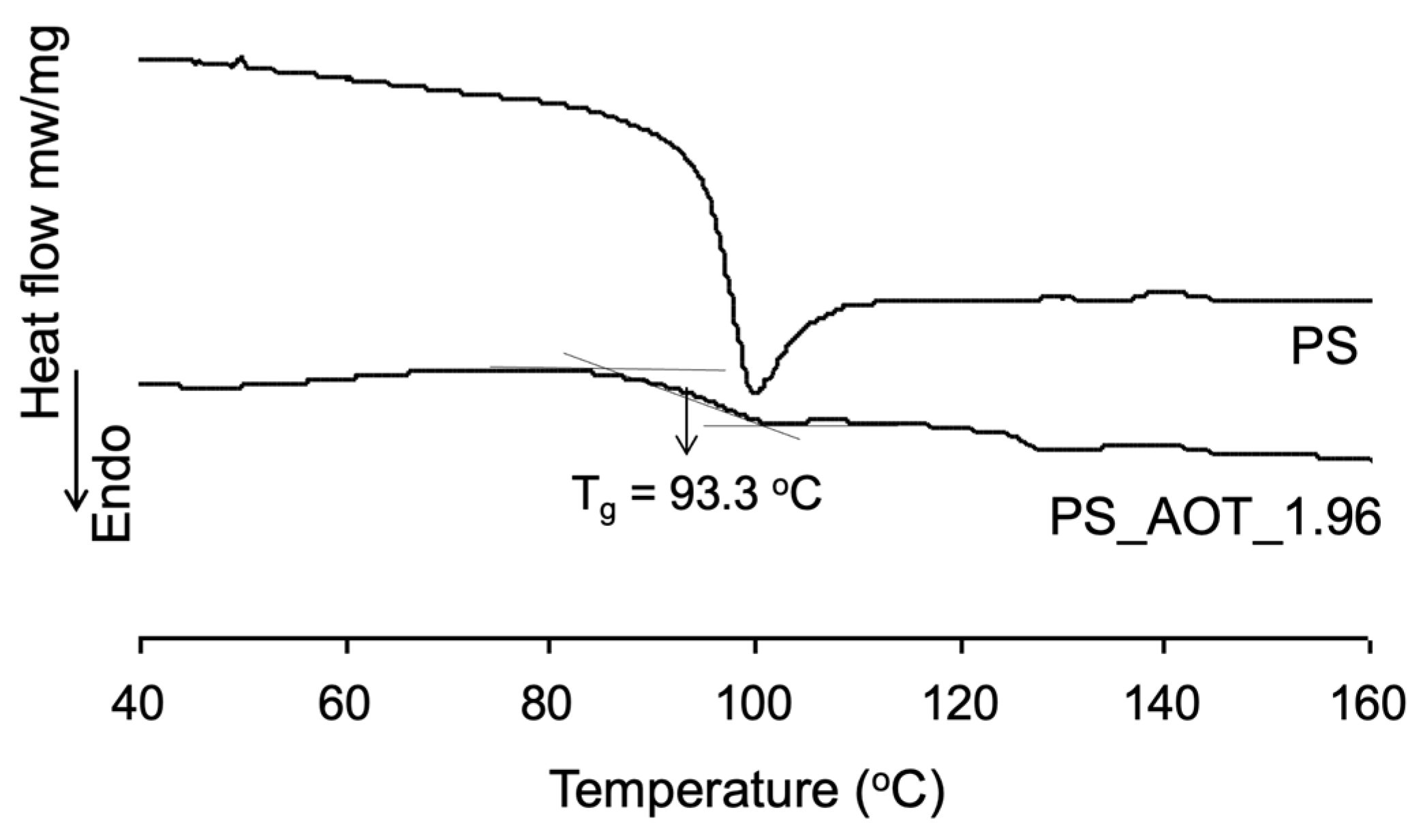
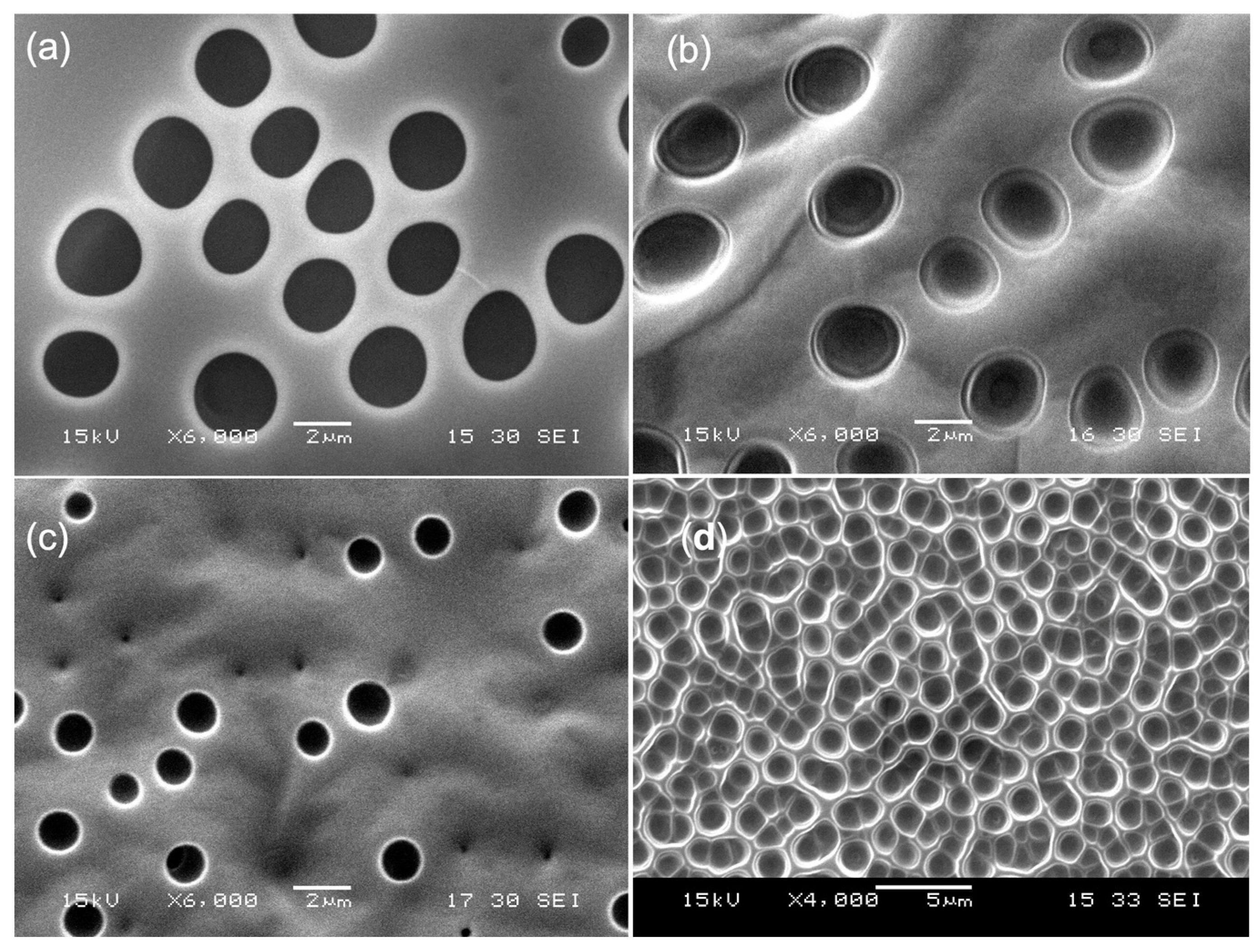
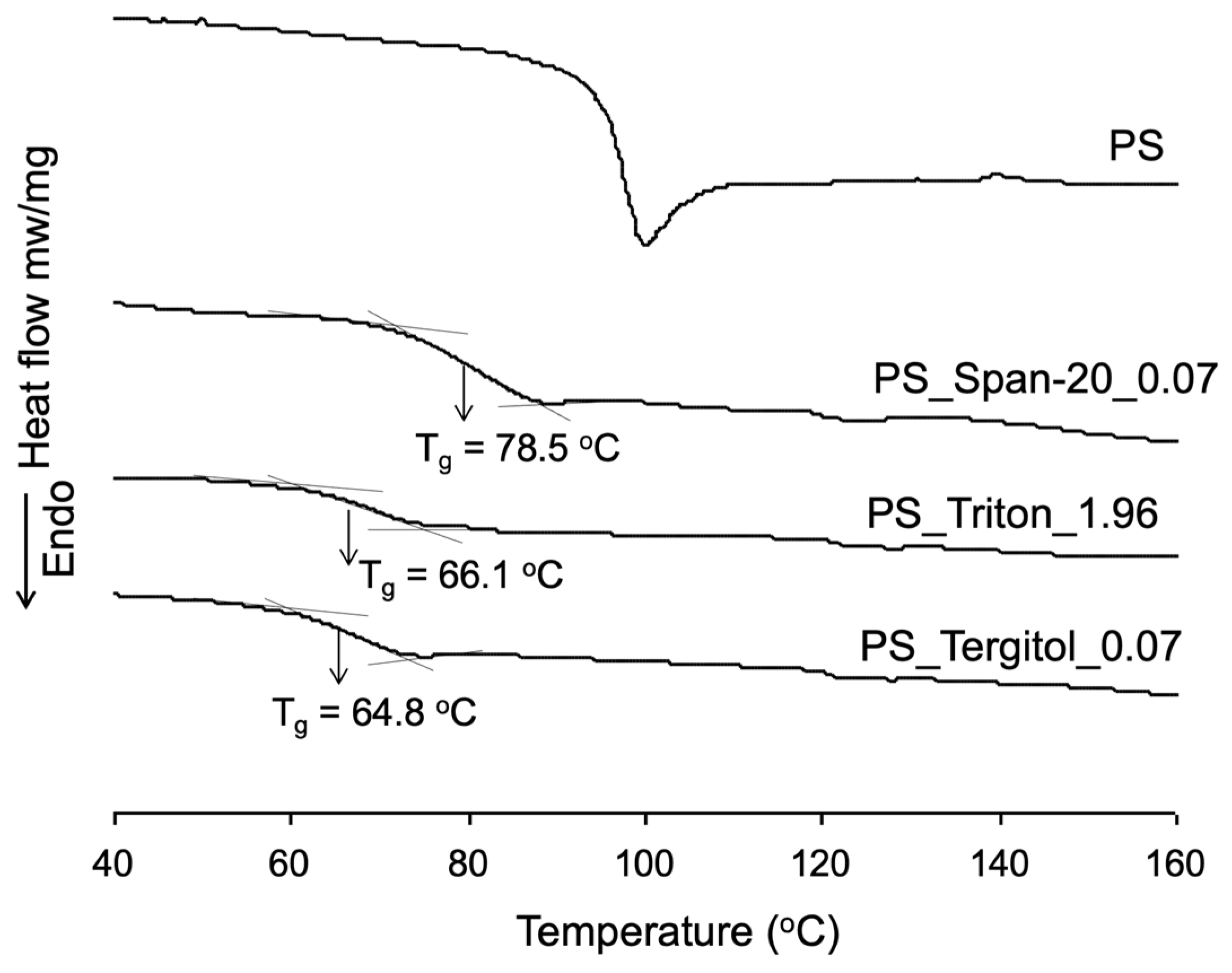

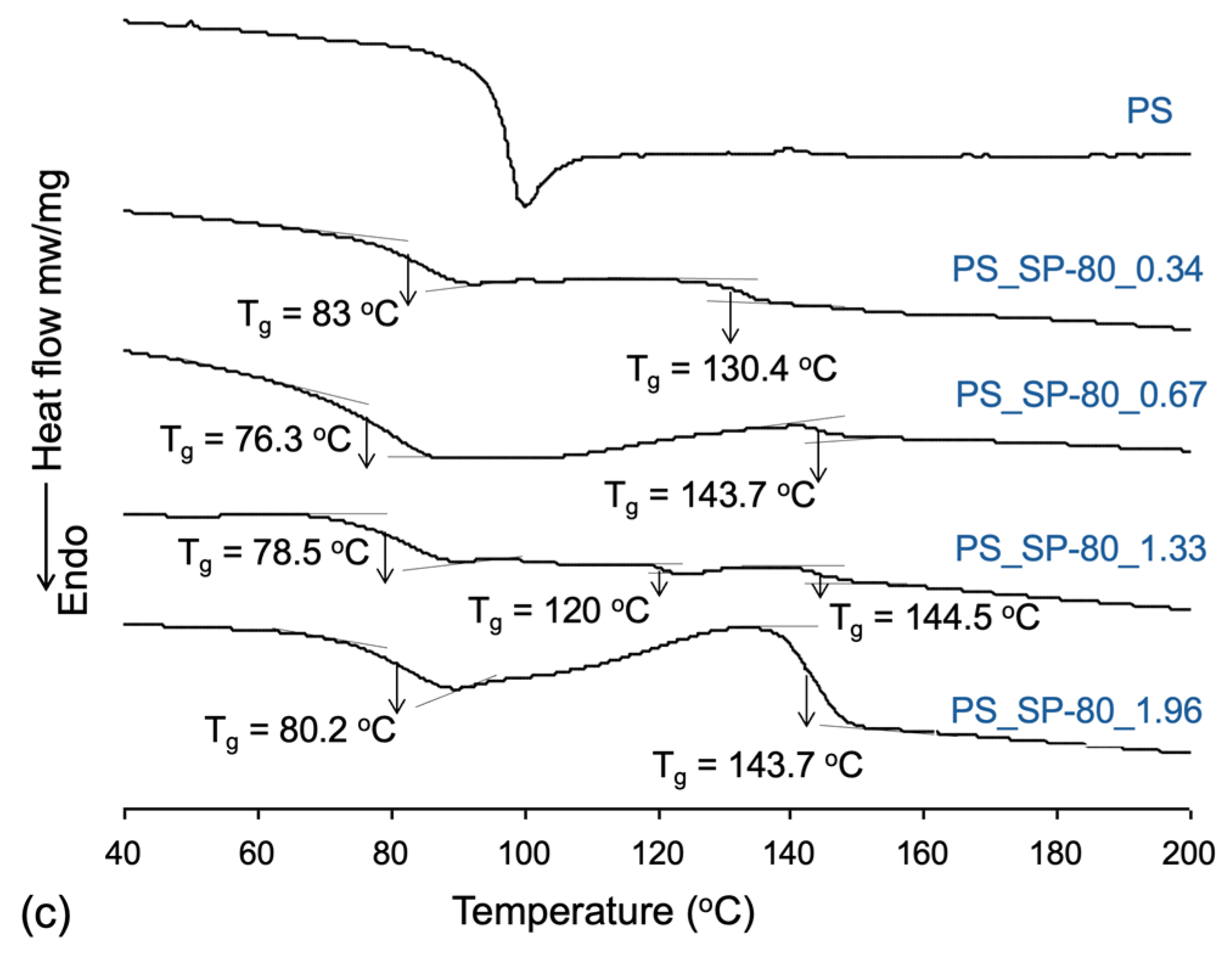



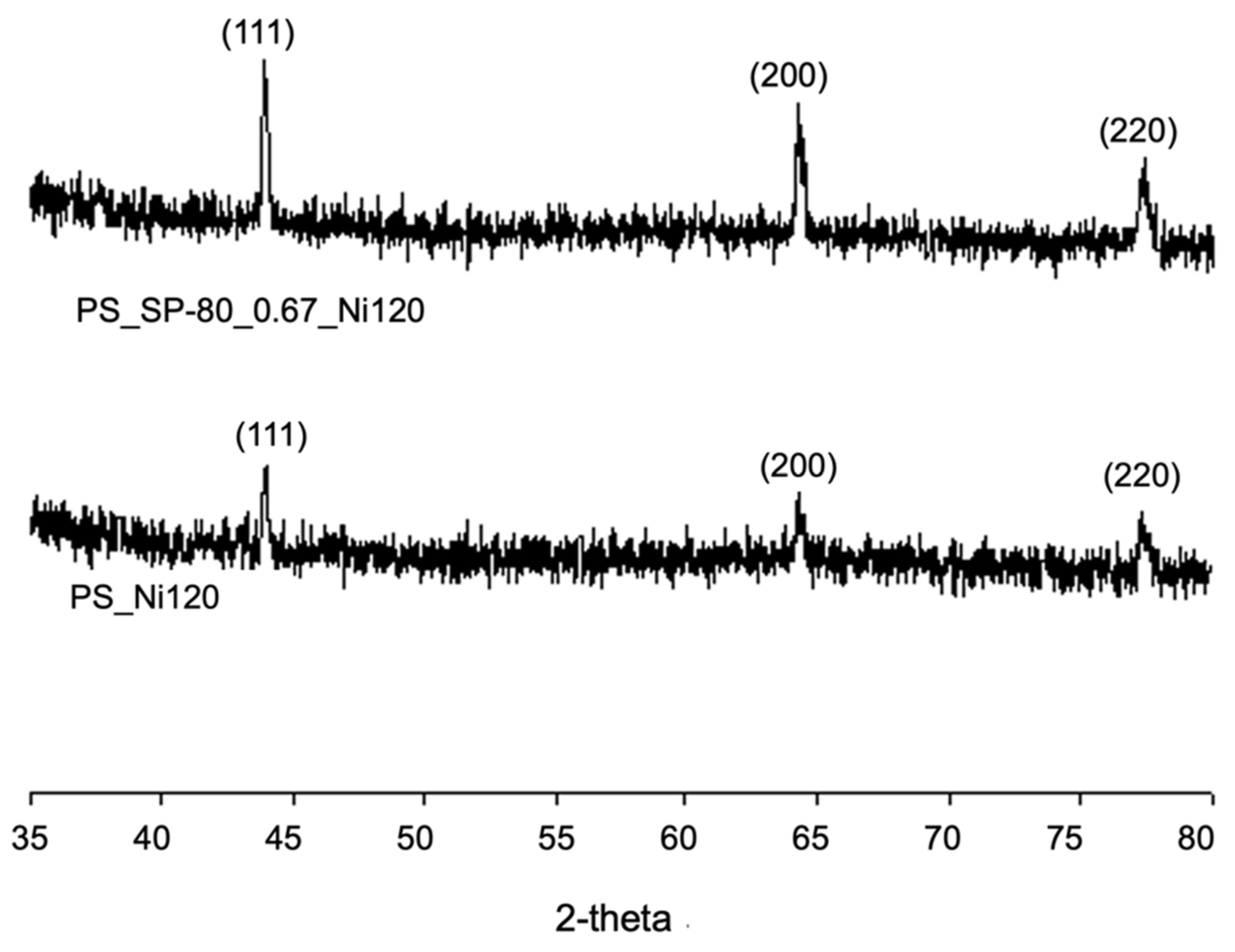
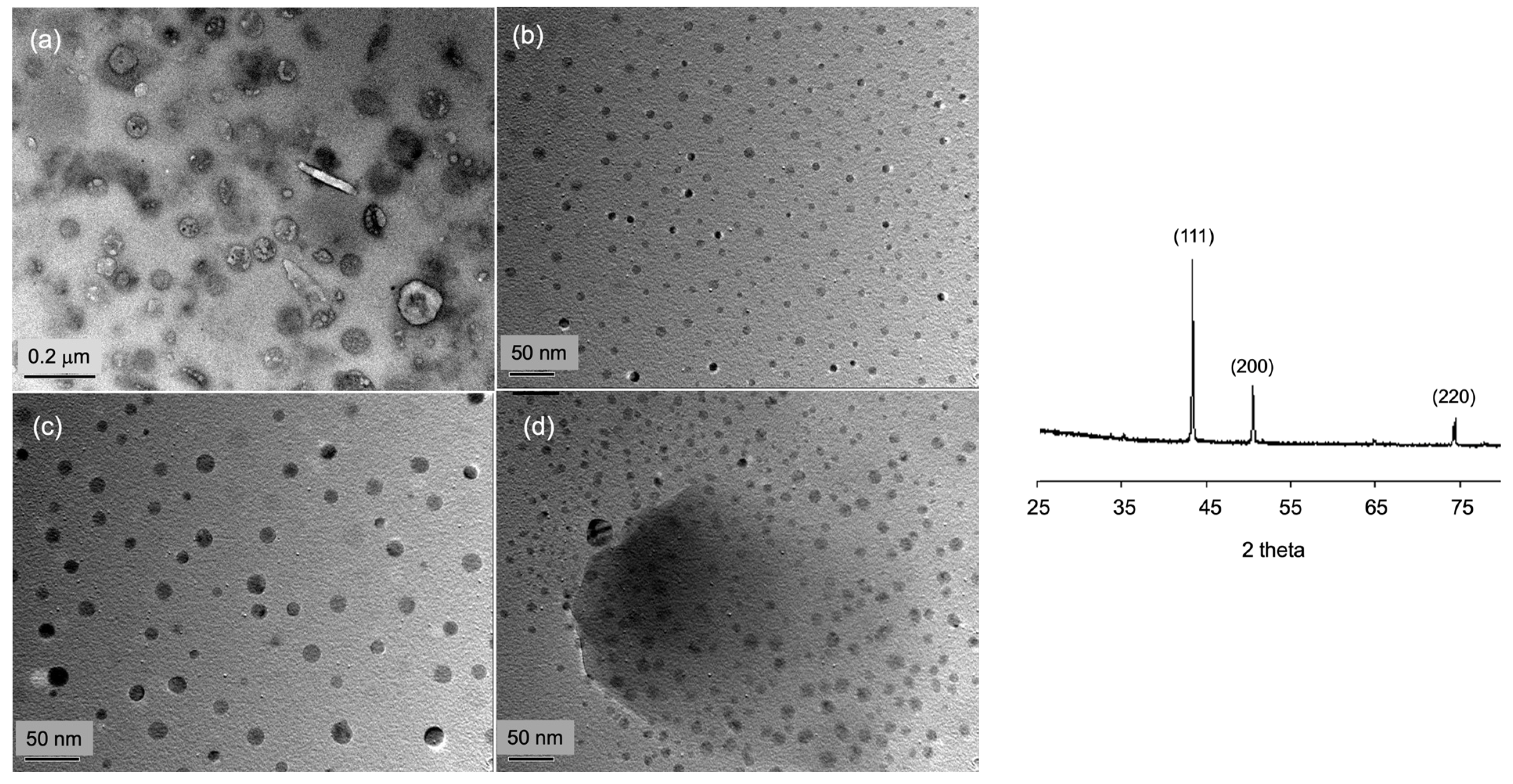

| Commercial Name | Charge Type | Chemical Name | HLB Value a/Solubility b (g/L) |
|---|---|---|---|
| AOT | Anionic | Sodium dioctyl sulfosuccinate | 10.5/14 |
| CTAB | Cationic | n-Hexadecyl trimethyl ammonium bromide | 10/36.4 |
| Span-80 | Non-ionic | Sorbitane mono-oleate | 4.3 b/insoluble |
| Span-20 | Non-ionic | Sorbitane mono-laurate | 8.6/0.2 |
| Triton X-100 | Non-ionic | t-Octylphenoxypolyethoxyethanol | 13.5/soluble |
| Tergitol NP-12 | Non-ionic | Nonylphenol ethoxylate | 13.8/soluble |
| Wt. % of CTAB in PS Film | Pore Diameters (μm) | Average Hole Diameters (μm) |
|---|---|---|
| 0.07 | 3.3–6.1 | 4.7 |
| 0.14 | 2.2–3.3 | 2.8 |
| 0.67 | 1.9–2.1 | 2.0 |
| 1.33 | - | - |
| Emulsion-Derived PS Film | RMS Roughness (nm) |
|---|---|
| PS_CTAB_0.67 | 10.2 |
| PS_AOT_1.96 | 3.2 |
| PS_Span-80_0.67 | 21.7 |
| PS_Triton_1.96 | 8.3 |
| PS_Tergitol_0.07 | 10.2 |
| PS_Span-20_0.67 | 11.7 |
| Hydrocarbon Tail | No. of the First-Order Groups a, and Their Corresponding Ci b | δtail (MPa)0.5 | δsurf (MPa)0.5 | |||||
|---|---|---|---|---|---|---|---|---|
| -CH3 | -CH2- | -CH< | -CH=CH- | ACH | AC | |||
| −0.9714 | −0.0269 | 0.6450 | 0.0048 | 0.1105 | 0.8446 | |||
| CTAB | 1 | 14 | 18.31 | 21.64 c | ||||
| AOT | 4 | 8 | 2 | 16.06 | - | |||
| Span-80 | 1 | 12 | 1 | 18.40 | 23.71 d | |||
| Span-20 | 1 | 9 | 18.52 | 26.04 | ||||
| Tergitol NP-12 | 1 | 8 | 4 | 1 | 20.60 | 26.57 | ||
| Triton X-100 | 1 | 7 | 4 | 1 | 20.64 | 26.37 | ||
| Sample | Crystallographic Planes and 2θ Angles | ||
|---|---|---|---|
| (111) | (200) | (220) | |
| PS_Span-80_0.67_Ni120 | 44.16 | 64.28 | 77.52 |
| PS_Ni120 | 44.41 | 64.38 | 77.62 |
| References [42,43] | 44.54 | 52.10 | 76.46 |
| Film Formed | CP (mL) a | DP (aq. soln., mL) a | vol.% of aq. Phase | |
|---|---|---|---|---|
| Copper Source aq. b | Hydrazine c | |||
| PS_Span-80_0.67_Cu0.7_w/o d | 10.48 | 0.7 (CuSO4) | 0.7/in situ | 11.78 |
| PS_Span-80_0.67_Cu0.7_w | 10.48 | 0.7 [Cu(4VPy)2SO4 plus free 4VPy] | 0.7/in situ | 11.78 |
| PS_Span-80_0.67_Cu0.7_w/rd | 10.48 | 0.7 [Cu(4VPy)2SO4] | 1.0/post | 16.02 |
Disclaimer/Publisher’s Note: The statements, opinions and data contained in all publications are solely those of the individual author(s) and contributor(s) and not of MDPI and/or the editor(s). MDPI and/or the editor(s) disclaim responsibility for any injury to people or property resulting from any ideas, methods, instructions or products referred to in the content. |
© 2024 by the authors. Licensee MDPI, Basel, Switzerland. This article is an open access article distributed under the terms and conditions of the Creative Commons Attribution (CC BY) license (https://creativecommons.org/licenses/by/4.0/).
Share and Cite
Hauan, Z.T.; Hong, L. Creating Diverse Patterns on Thin Polystyrene Film through Water-in-Oil Emulsion Coating and Utilizing the Derived Hydrophilic Holes as a Microreactor. Coatings 2024, 14, 956. https://doi.org/10.3390/coatings14080956
Hauan ZT, Hong L. Creating Diverse Patterns on Thin Polystyrene Film through Water-in-Oil Emulsion Coating and Utilizing the Derived Hydrophilic Holes as a Microreactor. Coatings. 2024; 14(8):956. https://doi.org/10.3390/coatings14080956
Chicago/Turabian StyleHauan, Zin Thwe, and Liang Hong. 2024. "Creating Diverse Patterns on Thin Polystyrene Film through Water-in-Oil Emulsion Coating and Utilizing the Derived Hydrophilic Holes as a Microreactor" Coatings 14, no. 8: 956. https://doi.org/10.3390/coatings14080956





